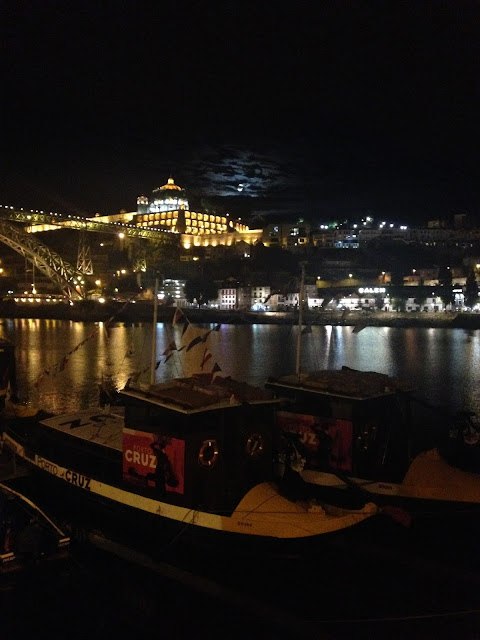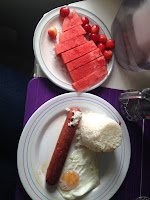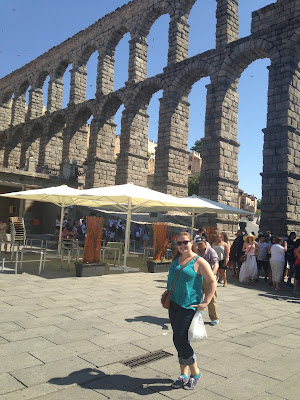This trip was one of the organized excursions through my study abroad program, so all of the transportation, accommodations, and tours were organized for us. We took a private bus from Salamanca after our classes finished on Friday, July 3. The trip to Porto was about five hours. Since Portugal and Spain are both part of the European Union, crossing the border into Spain was really nothing unless you were paying close attention. No passports or stopping required!
We arrived to Porto around 8 or 9 pm and then had a little bit of time before meeting up with the group to walk down to the waterfront together. The walk to the river was really pretty because the sun was setting.
The view at the waterfront was incredible! Lots of restaurants were situated along the river (Rio Duero in Spanish), so we split up into smaller groups and went off to find something to eat.
The group that I went with ended up at a small restaurant that mostly served seafood. We had an interesting time communicating with the waiters since we don't speak Portuguese. Thankfully, most Portuguese people speak at least some English. It was quite the interesting dinner because I ended up getting pooped on by some seagulls that were flying overhead, but the whole situation made for some good laughs. The photo below is with the restaurant owner and our two waiters.
After dinner, the group met up again and we trekked back uphill to our hotel.
The next morning we all got dressed in our red, white, and blue because it was the 4th of July!
We got a guided tour of Porto and got to see many of the popular sites.
Inside the bookstore that inspired J.K. Rowling's creation of Flourish and Blot's for the Harry Potter series. See the movie interpretation below as well.
Amazing tile murals inside Porto's train station. These kind of tiles are found all over the city, both on the interior and exterior of buildings. They are said to help protect the buildings from humidity, since Porto is a coastal city.
Looking out over Porto...
Once again, we ran into/crashed a wedding inside Porto's cathedral. The cathedrals can't be totally closed to the public during the ceremony, so I guess that's a sacrifice you make for getting married in such a cool place.
Walking through Porto: so pretty!
We ended our walking tour back on the waterfront.
And then we crossed that bridge that you see in the background on foot to see the panoramic view of Porto from the other side of the Rio Duero. Definitely worth it!! This is probably my favorite view of my whole trip so far.
With my roommate, Lynzee.
Porto is very famous for its wine, and this is just one of the MANY wine cellars found in the city.
Done with our tour of the city, we headed for a group lunch. One of the things we got to try is a typical pastry of Portugal, called pastel de nata in Spanish. Delicious!
A example of the buildings with tiled exteriors.
We had already had a great 4th of July in Porto, but the day wasn't over yet because it was time to go to the beach! For many of us, this was our first European beach experience. While it was a bit windy and chillier than some would have liked, we still had a great time. I had a blast swimming/jumping waves in the Atlantic.
After a few hours at the beach, we headed back to our hotel and had a free evening. Since it was the 4th of July, pretty much all of our group went out together. There ended up being a festival sponsored by a cider company and a band was playing, so we had a good time listening to live music there.
On Sunday morning, we had to be up bright and early to go to Coimbra, another city in Portugal. Coimbra is the home of the oldest university in Portugal. We got a tour of this university before heading back to Salamanca on the bus. It was super cool!
The view from the terrace of one of the university buildings.
Thanks for reading! Next up will be my weekend trip to San Sebastian on the northern coast of Spain.




















































